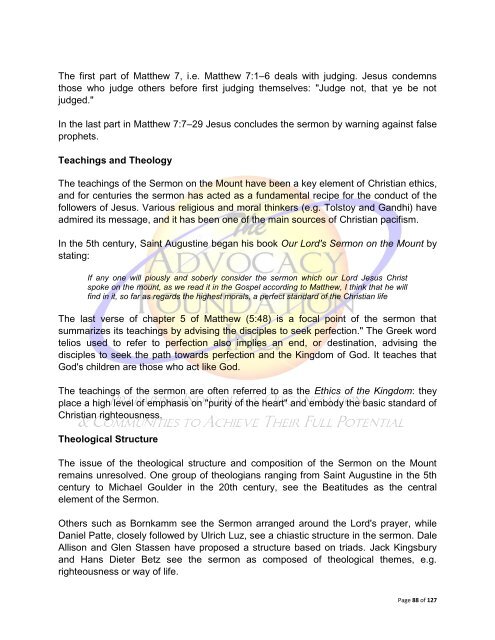Acquiesce to Righteousness
Acquiesce to Righteousness
Acquiesce to Righteousness
Create successful ePaper yourself
Turn your PDF publications into a flip-book with our unique Google optimized e-Paper software.
The first part of Matthew 7, i.e. Matthew 7:1–6 deals with judging. Jesus condemns<br />
those who judge others before first judging themselves: "Judge not, that ye be not<br />
judged."<br />
In the last part in Matthew 7:7–29 Jesus concludes the sermon by warning against false<br />
prophets.<br />
Teachings and Theology<br />
The teachings of the Sermon on the Mount have been a key element of Christian ethics,<br />
and for centuries the sermon has acted as a fundamental recipe for the conduct of the<br />
followers of Jesus. Various religious and moral thinkers (e.g. Tols<strong>to</strong>y and Gandhi) have<br />
admired its message, and it has been one of the main sources of Christian pacifism.<br />
In the 5th century, Saint Augustine began his book Our Lord's Sermon on the Mount by<br />
stating:<br />
If any one will piously and soberly consider the sermon which our Lord Jesus Christ<br />
spoke on the mount, as we read it in the Gospel according <strong>to</strong> Matthew, I think that he will<br />
find in it, so far as regards the highest morals, a perfect standard of the Christian life<br />
The last verse of chapter 5 of Matthew (5:48) is a focal point of the sermon that<br />
summarizes its teachings by advising the disciples <strong>to</strong> seek perfection." The Greek word<br />
telios used <strong>to</strong> refer <strong>to</strong> perfection also implies an end, or destination, advising the<br />
disciples <strong>to</strong> seek the path <strong>to</strong>wards perfection and the Kingdom of God. It teaches that<br />
God's children are those who act like God.<br />
The teachings of the sermon are often referred <strong>to</strong> as the Ethics of the Kingdom: they<br />
place a high level of emphasis on "purity of the heart" and embody the basic standard of<br />
Christian righteousness.<br />
Theological Structure<br />
The issue of the theological structure and composition of the Sermon on the Mount<br />
remains unresolved. One group of theologians ranging from Saint Augustine in the 5th<br />
century <strong>to</strong> Michael Goulder in the 20th century, see the Beatitudes as the central<br />
element of the Sermon.<br />
Others such as Bornkamm see the Sermon arranged around the Lord's prayer, while<br />
Daniel Patte, closely followed by Ulrich Luz, see a chiastic structure in the sermon. Dale<br />
Allison and Glen Stassen have proposed a structure based on triads. Jack Kingsbury<br />
and Hans Dieter Betz see the sermon as composed of theological themes, e.g.<br />
righteousness or way of life.<br />
Page 88 of 127

















